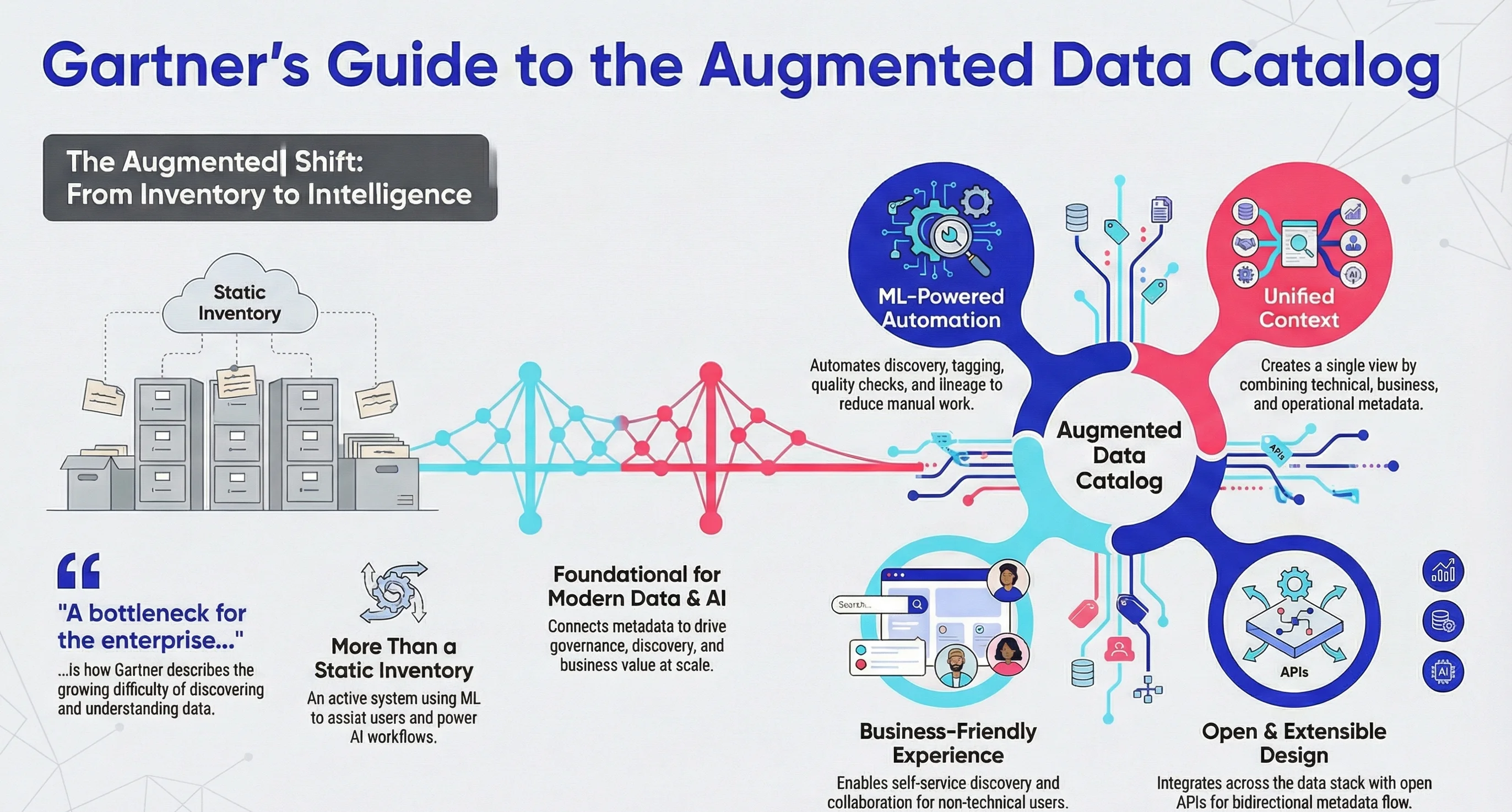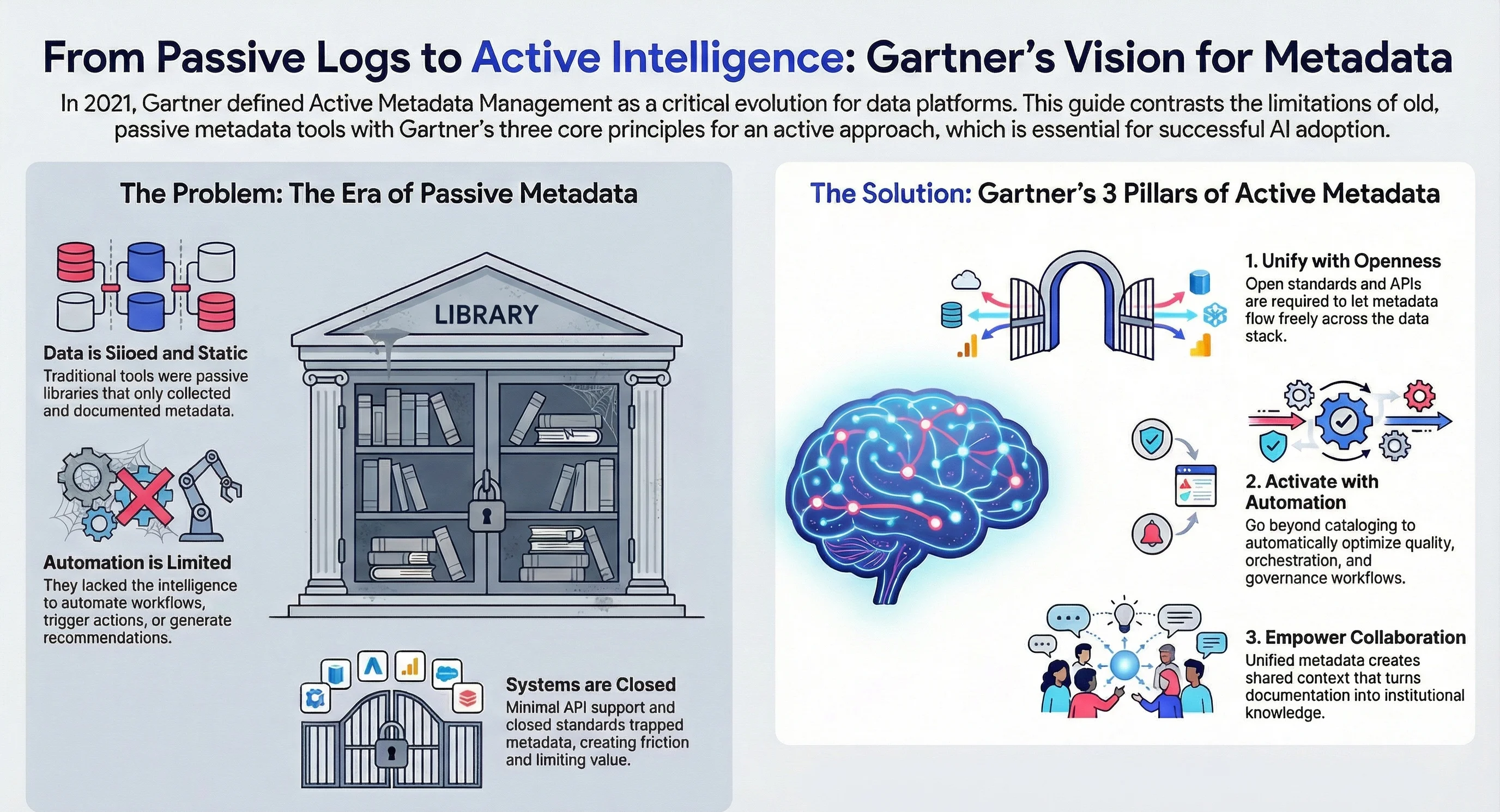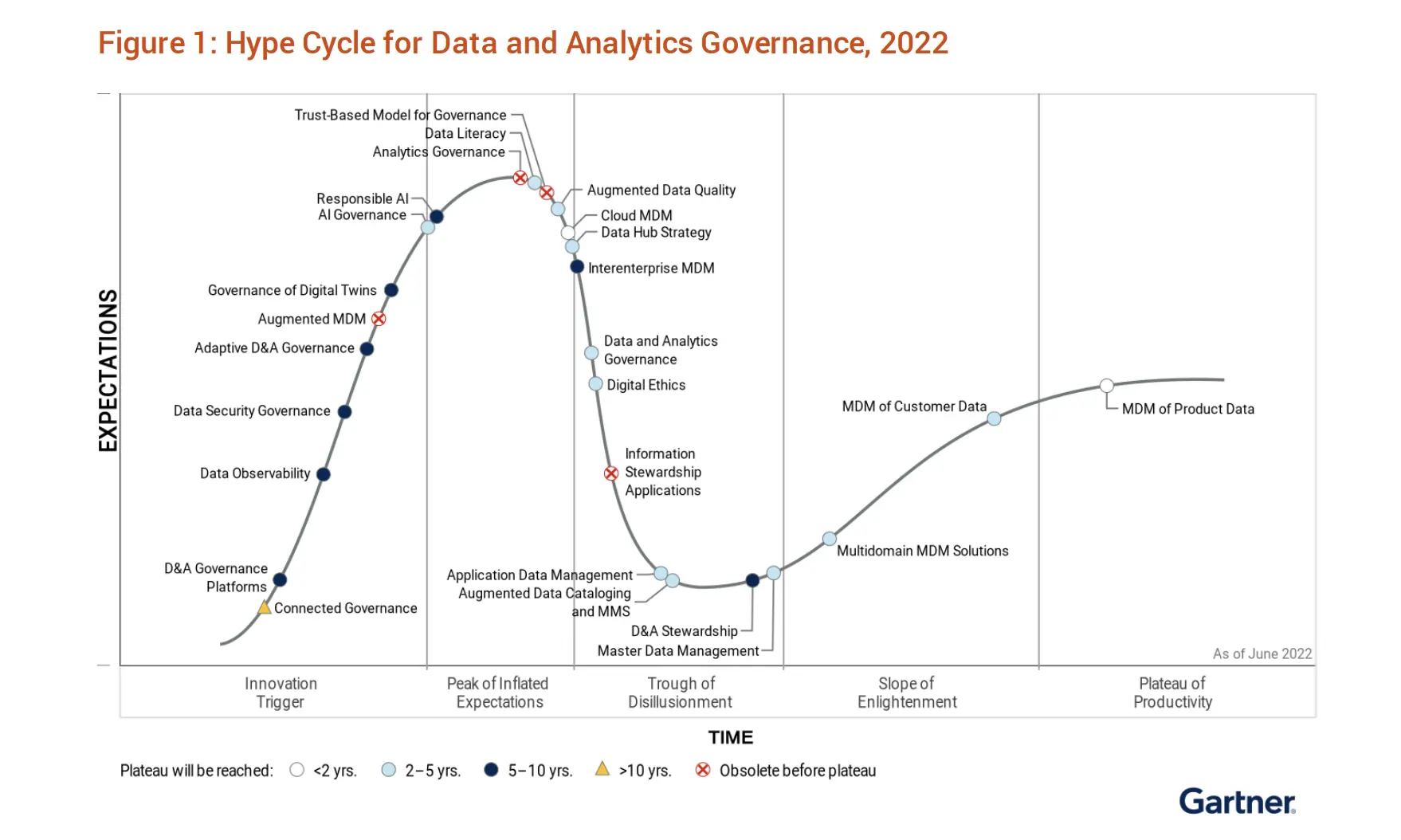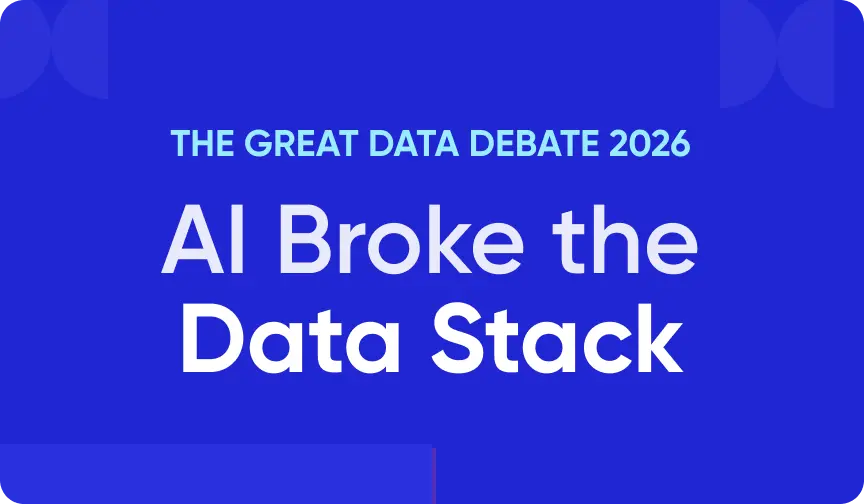Gartner Data Catalog Market Guide 2026: What Buyers Need
How does Gartner help you pick the right data catalog for your enterprise?
Permalink to “How does Gartner help you pick the right data catalog for your enterprise?”Gartner is a leading technology research and advisory firm that helps organizations make informed decisions across complex technology markets. Through research reports, analytical frameworks, and practitioner insights, Gartner enables buyers to understand markets, assess vendors, and reduce the risk of costly platform decisions.
When it comes to selecting a data catalog, Gartner does not rely on a single, one size fits all framework. Instead, it offers a set of complementary research lenses that together provide a clearer, more practical view of the market.
What Gartner focuses on in modern data catalog research:
Permalink to “What Gartner focuses on in modern data catalog research:”Recent Gartner research reflects how quickly the category is changing and what enterprises should prioritize when evaluating solutions.
AI driven evolution
Permalink to “AI driven evolution”Metadata management is shifting from traditional or augmented data catalogs toward broader metadata orchestration platforms. These platforms support production AI by making metadata accessible wherever it is needed, not just inside a single tool.
Active over passive metadata
Permalink to “Active over passive metadata”Modern platforms are expected to automate discovery, governance, quality signals, and lineage. Static documentation is no longer sufficient. Gartner emphasizes bidirectional metadata flows so insights move seamlessly across the data stack.
Open and extensible architecture
Permalink to “Open and extensible architecture”APIs are critical. Gartner highlights the need for open architectures that allow metadata to flow freely across BI tools, data platforms, governance systems, and collaboration tools.
Business user accessibility
Permalink to “Business user accessibility”Data catalogs are no longer built only for data engineers. Gartner consistently points out the importance of intuitive, self service experiences for non technical users who need to find, understand, and trust data.
How Gartner structures vendor evaluation
Permalink to “How Gartner structures vendor evaluation”Rather than relying on a single report, Gartner uses multiple frameworks to address different evaluation needs. It is also worth noting that Gartner does not currently publish a Magic Quadrant dedicated to “Data Catalogs.” Instead, data catalog capabilities are assessed across related research areas such as metadata management, data analytics, and data governance.
Key Gartner research formats include:
- Gartner Magic Quadrant for competitive positioning in adjacent categories
- Gartner Market Guide for market direction and representative vendors
- Gartner Peer Insights for verified customer reviews
- Gartner Hype Cycle for technology maturity
- Gartner Cool Vendors for emerging solutions
- Gartner Vendor Ratings for overall vendor assessment
1. Gartner Magic Quadrant for metadata management 2025
Permalink to “1. Gartner Magic Quadrant for metadata management 2025”After a five year gap, Gartner reintroduced the Magic Quadrant for Metadata Management Solutions in November 2025. Its return signals a clear shift. Metadata management is now foundational to AI readiness and modern data strategy, not a supporting capability.
The 2025 report evaluates 15 vendors across two dimensions:
- Completeness of vision
- Ability to execute
Vendors are positioned as Leaders, Challengers, Visionaries, or Niche Players.
Why metadata matters now
Permalink to “Why metadata matters now”Gartner points to a fundamental market transition:
- Metadata platforms are evolving from augmented data catalogs into metadata anywhere orchestration platforms
- Metadata now underpins production AI, where context, lineage, and governance directly impact accuracy and trust
The report is clear. AI success requires metadata maturity. Enterprises need platforms that:
- Unify technical, business, and operational metadata
- Operate across distributed, hybrid, and multi cloud environments
- Activate metadata in real time for both human workflows and AI systems
Evaluation criteria for modern platforms
Permalink to “Evaluation criteria for modern platforms”Gartner assesses vendors across several strategic criteria:
- Breadth of metadata management capabilities
- Support for discovery, governance, quality, and AI use cases
- Integration depth and open APIs
- Automation that reduces manual effort
- Scalability across complex enterprise environments
- User adoption and time to value
Adoption and activation are no longer secondary. They are core differentiators.
Atlan recognized as a Leader
Permalink to “Atlan recognized as a Leader”Atlan was named a Leader in the 2025 Gartner Magic Quadrant for Metadata Management Solutions, recognized for its ability to unify metadata across enterprises and activate it for both human and AI workflows.
Key highlights include:
- A metadata lakehouse architecture that creates a single active context layer
- Over 90 percent non technical user adoption within 90 days
- Fastest time to value through automation first design and DIY connectors
Enterprises such as Mastercard, General Motors, and Nasdaq use Atlan as their metadata foundation for AI governance and context aware analytics.
Atlan also holds a 4.6 star rating on Gartner Peer Insights, with customers citing fast deployment, intuitive user experience, and an open integration model as key strengths.
See Why Atlan is a Leader
Take the Product Tour →2. Gartner Market Guide for data catalogs
Permalink to “2. Gartner Market Guide for data catalogs”Gartner Market Guide helps organizations understand risks and benefits associated with emerging trends and markets. The guide addresses questions like “What would we miss if we don’t invest in data catalog tools now?” and “What capabilities are driving this trend?”
According to Gartner, Market Guides are most valuable when new markets emerge and offerings are difficult to compare, or when markets mature to where offerings become interchangeable. In these scenarios, analysis of and recommendations about the market itself becomes more important than competitive positioning.
Two key Market Guides help evaluate data catalog and metadata management solutions:
- Augmented Data Catalogs: Now an Enterprise Must-Have for Data and Analytics Leaders
- Market Guide for Active Metadata Management
These guides provide market definition, direction analysis, vendor profiles, and strategic recommendations for data leaders evaluating catalog technologies.
Gartner Market Guide: Augmented Data Catalogs
Permalink to “Gartner Market Guide: Augmented Data Catalogs”As data volumes, sources, and architectures grow rapidly, discovering and understanding data has become an enterprise bottleneck. Gartner’s Market Guide for Augmented Data Catalogs helps organizations navigate the shift from passive documentation to active, intelligence driven metadata platforms.
The research connects current catalog capabilities with future needs as metadata becomes foundational to analytics, governance, and AI.
What Gartner emphasizes
Permalink to “What Gartner emphasizes”Gartner positions augmented data catalogs as systems that actively assist users and AI, not static inventories. Core focus areas include:
- ML driven automation
- Comprehensive metadata coverage
- Business user accessibility
- Open API architecture
Core evaluation themes
Permalink to “Core evaluation themes”ML augmented automation
Automates discovery, search, recommendations, quality checks, and governance tagging to reduce manual effort at scale.
Unified metadata inventory
Brings technical, business, operational, governance, and social metadata into a single source of context.
Business friendly experience
Translates technical metadata into intuitive, self service workflows for non technical users enabling true data democratization.
Open and extensible design
Modern and enables bidirectional metadata flow across tools through open APIs and native integrations.

Gartner Market Guide | Augmented Data Catalog. Source: Atlan.
Key components of augmented data catalogs
Permalink to “Key components of augmented data catalogs”-
Automated discovery and scanning
Continuously crawls data sources and pipelines to keep metadata current.
-
Trust and quality signals
Surfaces profiling, freshness, and reliability indicators for faster decision making.
-
Embedded collaboration
Enables in context ratings, comments, and usage signals around data assets.
-
Governance and compliance
Automates lineage, sensitive data classification, and policy enforcement.
Together, these components define augmented data catalogs as active metadata platforms that support analytics, governance, and AI at enterprise scale.
Gartner Market Guide: Active Metadata Management
Permalink to “Gartner Market Guide: Active Metadata Management”In July 2021, Gartner introduced the Market Guide for Active Metadata Management to signal a major shift in how metadata platforms should operate. Traditional solutions were largely passive. They collected and documented metadata but stopped short of driving action. These tools were limited in automation, weak in ML support, and often closed systems with minimal API extensibility.
Gartner defined active metadata management as an emerging capability spanning multiple data management markets. For data and analytics leaders, this evolution is not incremental. It is transformational for every data enabling technology, especially as AI adoption accelerates.
Gartner recommendations for active metadata
Permalink to “Gartner recommendations for active metadata”Gartner outlines three core principles that define active metadata platforms.
Openness as a requirement
Closed metadata standards create silos and limit reuse. Gartner emphasizes open standards and APIs so metadata can move freely across the data stack and power downstream tools and workflows.
Automation beyond cataloging
Active metadata platforms go past discovery and lineage. They automate workflows, trigger policies, generate recommendations, and optimize data quality, orchestration, and cost based on real usage and context.
Collaboration through unified metadata
When metadata is unified, teams can collaborate through shared context. Ratings, tags, conversations, and certifications turn metadata into institutional knowledge rather than isolated documentation

Gartner Market Guide: Active Metadata Management. Source: Atlan.
How Gartner evaluates vendors
Permalink to “How Gartner evaluates vendors”Gartner includes representative vendors offering active metadata and data catalog capabilities. Evaluation focuses on:
- Automation depth
- Openness and integration flexibility
- Collaboration support
- Fit across use cases and deployment models
Buyers are advised to assess vendors based on their existing stack, governance maturity, AI strategy, and adoption goals. Active metadata is positioned not as a standalone tool, but as a foundation for scalable analytics, governance, and AI.
3. Gartner Hype Cycle for data technologies
Permalink to “3. Gartner Hype Cycle for data technologies”The Gartner Hype Cycle provides graphical representation of technology maturity and adoption, showing how technologies are potentially relevant to solving real business problems and exploiting new opportunities.
The hype cycle plots “expectation” of technology against “time” across five phases: innovation trigger, peak of inflated expectations, trough of disillusionment, slope of enlightenment, and plateau of productivity.

Gartner Hype Cycle for data technologies. Source: Gartner.
Hype Cycles related to data catalogs
Permalink to “Hype Cycles related to data catalogs”Several Hype Cycles provide perspective on data catalog and metadata management maturity:
- Hype Cycle for Data and Analytics Governance
- Hype Cycle for Analytics and Business Intelligence
- Hype Cycle for Data Science and Machine Learning
- Hype Cycle for Privacy
These cycles help organizations understand where specific capabilities sit in the maturity curve and set realistic expectations for implementation timelines and benefits realization.
4. Gartner Peer Insights for data catalogs
Permalink to “4. Gartner Peer Insights for data catalogs”Gartner Peer Insights is a platform collecting reviews of popular software and technology services from users and practitioners. The platform covers more than 400 categories of software services, spanning 18,000 products with 450,000 reviews.
Organizations can search through reviews using criteria like geography, business size, total revenue, industry, and ratings. The platform allows product comparison to ascertain key differences between vendors.
For data catalog evaluation, check Gartner Metadata Management Solutions Reviews and Ratings and Active Metadata Management Reviews. These platforms provide unfiltered customer perspectives on implementation experiences, vendor support quality, and realized business value.
Peer reviews complement analyst research by providing real-world validation of vendor claims and highlighting implementation challenges that may not surface in formal evaluations.
Real stories from real customers: How organizations maximize data value with Atlan
Permalink to “Real stories from real customers: How organizations maximize data value with Atlan”Organizations across industries use Atlan to power their metadata foundation for AI governance and context-aware analytics. The platform’s recognition in multiple Gartner reports reflects its proven ability to deliver business outcomes.

From Hours to Minutes: How Aliaxis Reduced Effort on Root Cause Analysis by almost 95%
“A data product owner told me it used to take at least an hour to find the source of a column or a problem, then find a fix for it, each time there was a change. With Atlan, it’s a matter of minutes. They can go there and quickly get a report.”
Data Governance Team
Aliaxis
🎧 Listen to AI-generated podcast: How Aliaxis Reduced Effort on Root Cause Analysis

From Weeks to Hours: How Tide Automated GDPR Compliance
“We needed to tag personally identifiable information across our entire data estate to strengthen GDPR compliance for 500,000 customers. Manual processes would have taken 50 days. Using automated rule-based workflows, we completed the tagging in just five hours.”
Data Governance Team
Tide
🎧 Listen to AI-generated podcast: Tide’s active governance journey
Key takeaways on Gartner data catalog research
Permalink to “Key takeaways on Gartner data catalog research”The data catalog and metadata management market has fundamentally shifted. Gartner’s return to the Magic Quadrant in 2025, after a five year gap, signals that metadata is now critical to AI success, not a supporting capability. Passive catalogs are no longer sufficient. Enterprises need active, open platforms that orchestrate metadata across tools, teams, and systems.
Gartner’s research offers multiple evaluation lenses, from competitive positioning to peer validation, helping data leaders assess platforms through the realities of AI readiness, governance, and scale. Modern metadata platforms like Atlan align closely with this vision by unifying context, automating workflows, and activating metadata for both human and AI use cases across the enterprise.
Explore how Atlan’s metadata platform aligns with Gartner’s research insights for modern data and AI governance.
FAQs about Gartner data catalog research
Permalink to “FAQs about Gartner data catalog research”1. Does Gartner have a Magic Quadrant specifically for data catalogs?
Permalink to “1. Does Gartner have a Magic Quadrant specifically for data catalogs?”Gartner does not publish a standalone Magic Quadrant for data catalogs. However, the 2025 Magic Quadrant for Metadata Management Solutions evaluates platforms that include comprehensive data catalog capabilities as core functionality. This broader scope reflects market evolution where catalogs are part of larger metadata management and governance platforms rather than standalone tools.
2. What is the difference between Gartner’s Market Guide and Magic Quadrant?
Permalink to “2. What is the difference between Gartner’s Market Guide and Magic Quadrant?”Market Guides provide overview of emerging or maturing markets, focusing on market direction, trends, and representative vendors rather than competitive positioning. Magic Quadrants evaluate vendors within established markets based on execution ability and vision completeness, positioning them as Leaders, Challengers, Visionaries, or Niche Players. Market Guides help understand whether to invest in a technology category, while Magic Quadrants help select specific vendors.
3. How often does Gartner update its data catalog research?
Permalink to “3. How often does Gartner update its data catalog research?”Gartner updates research on an ongoing basis as markets evolve. The Metadata Management Magic Quadrant returned in 2025 after a five-year pause, while Market Guides and Hype Cycles typically update annually or biennially. Peer Insights updates continuously as customers submit new reviews. Organizations should check publication dates and consider how rapidly the market is changing when evaluating research relevance.
4. What is active metadata management according to Gartner?
Permalink to “4. What is active metadata management according to Gartner?”Active metadata management refers to capabilities that enable metadata to drive actions and automate workflows rather than serving as passive inventory. According to Gartner’s 2021 Market Guide, active metadata enables intelligent recommendations, workflow optimization, and automated governance enforcement. The approach unifies metadata from diverse sources and makes it actionable across tools where work happens rather than locked in a separate system.
5. How can I access Gartner research on data catalogs?
Permalink to “5. How can I access Gartner research on data catalogs?”Gartner research is available through Gartner client subscriptions. Some reports may be available through vendor websites like Atlan’s resource library where vendors share complimentary copies of research in which they are featured. Gartner Peer Insights reviews are publicly accessible without subscription for direct customer perspectives on vendor capabilities.
6. What makes a data catalog “augmented” according to Gartner?
Permalink to “6. What makes a data catalog “augmented” according to Gartner?”Augmented data catalogs use machine learning and AI to automate traditionally manual tasks like metadata tagging, data profiling, and relationship discovery. These catalogs intelligently recommend relevant datasets, automatically classify sensitive data, and learn from user behavior to improve search relevance. Augmentation reduces the effort required to maintain comprehensive metadata while improving accuracy and consistency.
Share this article
Atlan is the next-generation platform for data and AI governance. It is a control plane that stitches together a business's disparate data infrastructure, cataloging and enriching data with business context and security.
Gartner data catalog: Related reads
Permalink to “Gartner data catalog: Related reads”- Guide to Gartner Data Governance Research
- Gartner Active Metadata Management
- Gartner on Data Mesh
- Gartner on Data Fabric
- Gartner on Data Lineage
- Gartner on DataOps
- Gartner Magic Quadrant for Metadata Management
- Gartner Magic Quadrant for Data Quality
- Data Catalog: What It Is & How It Drives Business Value
- What Is a Data Lake and Why It Needs a Data Catalog
- Top data catalog tools — Compare the top data catalog tools of 2026
- Data Lineage Tracking | Why It Matters, How It Works & Best Practices for 2026
- Data Catalog Examples | Use Cases Across Industries and Implementation Guide
- Data Lineage Solutions| Capabilities and 2026 Guidance
- Features of Machine Learning Data Catalog - 2025 Guide
- 7 Top AI Governance Tools Compared | A Complete Roundup for 2026
- Best Data Governance Tools in 2026 — A Complete Roundup of Key Capabilities
- Features of Machine Learning Data Catalog - 2025 Guide
- Can Metadata Catalogs Enhance Data Discovery & Access?
- 5 Best Data Governance Platforms in 2026 | A Complete Evaluation Guide to Help You Choose
- 11 Best Data Governance Software in 2026 | A Complete Roundup of Key Strengths & Limitations
- The Modern Data Catalog Platform: More Value and a Better UX
- Data Catalog Evaluation Checklist to Boost Business Value






















